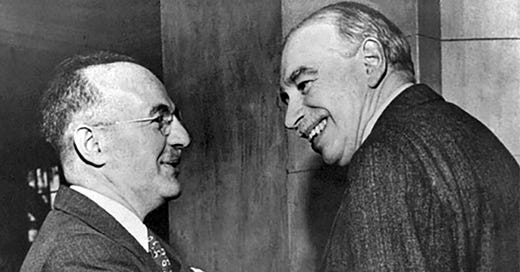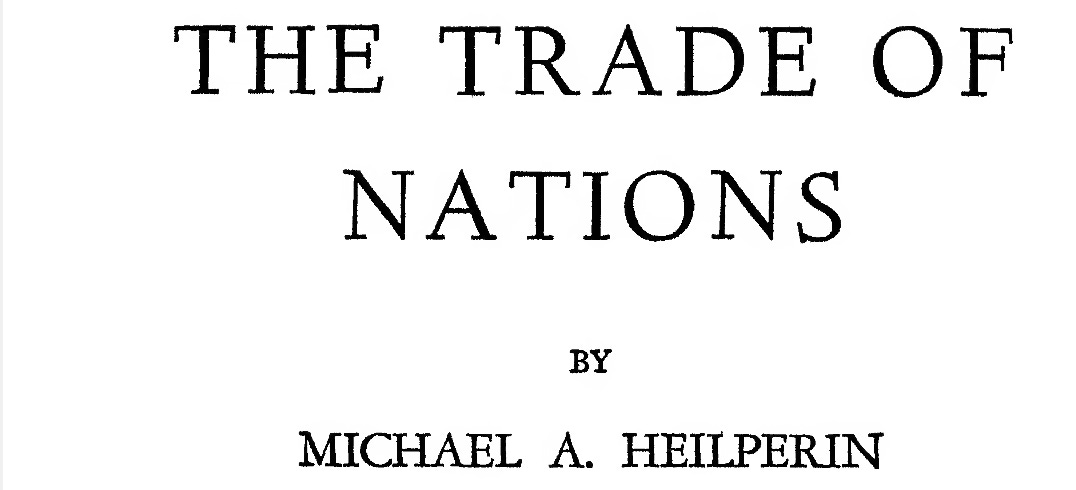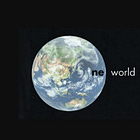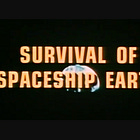Through the institutionalisation of Keynesian economic principles, and the embedding of fiscal and monetary policies within global financial institutions, the 1944 Bretton Woods Conference1 laid the foundation for a new economic order.
While we previously touched upon this in Crisis Economics, now seems an appropriate time to revisit it—given recent posts—to assemble a few more of the final pieces of the puzzle.
The Bretton Woods (1944) system2 established a fixed exchange rate regime where currencies were pegged to the US dollar, which in turn was backed by gold. This arrangement helped stabilise currencies, enabling governments to manage demand without suffering disruptive exchange-rate collapses.
Key elements of the Bretton Woods system included:
Fixed-but-Adjustable Exchange Rates: Provided currency stability while allowing governments some flexibility to manage their economies.
Capital Controls: Allowed nations to prevent speculative capital flows, giving them greater freedom to run expansionary fiscal policies.
IMF and World Bank as Stabilisers: These institutions provided financial support to nations facing balance-of-payments issues and funded post-war reconstruction and development.
Institutionalising Keynesian Economics: Governments were encouraged to manage demand, employment, and economic stability through coordinated fiscal and monetary policies.
While Keynes' original vision of an international clearing union was not fully realised, the system nonetheless supported global economic recovery and stability in the post-war decades.
The International Currency Experience3 (1944) examined the interwar period (1918–1939) and outlined lessons for monetary policy and central bank coordination. It analysed:
The stabilisation and destabilisation of currencies in the 1920s and 1930s.
The failures of the gold exchange standard and rigid currency cover requirements.
The importance of central bank cooperation to avoid competitive deflation and monetary crises.
The report's findings influenced Bretton Woods by promoting the idea that currency stability required international coordination of monetary policies, with institutions like the IMF managing currency fluctuations. But it also firmly placed the Bank for International Settlements in a pivotal role, working to facilitate the coordination of global monetary policy.
Economic Stability in a Post-War World4 (1945) strongly advocated for Keynesian countercyclical fiscal policy, reinforcing the need for government intervention to sustain economic stability. It argued that fiscal spending, coupled with managed monetary policy, could smooth economic cycles, prevent depressions, and maintain full employment.
By promoting deficit-financed public investment and government intervention in demand management, this work helped establish Keynesian economics as the guiding philosophy of post-war economic governance.
And it further suggested harmonising policy internationally, to aid this objective.
The The Trade of Nations5 (1946) positioned trade liberalization as a key strategy for post-war economic growth, arguing that free trade, reduced tariffs, free movement, and the integration of global markets were essential. It asserted that:
International trade fosters peace and economic prosperity.
Interwar protectionist policies had exacerbated global economic instability.
Free trade complemented Keynesian economic management by supporting domestic fiscal policies.
The document linked trade liberalisation to broader efforts in international governance, aligning with ideas from Leo Woolf’s International Government and advocating for economic interdependence as a means of securing global stability.
Money and the Coming World Order6 (1976) examined how Keynesian principles, institutionalised at Bretton Woods, continued to shape international financial institutions even after the collapse of fixed exchange rates in the early 1970s. It argued that:
The IMF and World Bank remained central actors in global economic governance, maintaining Keynesian-inspired stabilisation mechanisms.
Floating exchange rates did not eliminate Keynesian interventionist policies but shifted them towards coordinated economic management among central banks.
The evolution of monetary institutions ensured that global finance continued to be structured within the Keynesian framework, despite the rise of monetarist thought.
This confirmed that the institutions established in the 1940s had not lost their Keynesian roots but had instead adapted to changing economic realities. And it also confirmed the progressive developments, outlined by the four above reports.
Through The Post-War Origins of the Global Environment: How the United Nations Built Spaceship Earth7 (2018), environmental concerns gradually became embedded within the global economic framework:
International institutions initially focused on economic development began incorporating environmental governance into their mandates.
The 'One World' vision that had driven economic cooperation expanded to include sustainability, leading to frameworks such as the Earth Charter and UN environmental programmes.
Scientific collaborations and global resource management strategies set the stage for modern environmental policy within global governance structures.
This demonstrates a progression from Keynesian economic intervention outlined through the five reports above, to a broader governance model centred around environmental oversight.
Initially, fiscal and monetary policy worked together to promote economic stability. However, by the 1970s, central banks gained increasing independence, prioritising monetary control over fiscal expansion. The trajectory can be summarised as follows:
1950s–1960s: Fiscal and monetary policy were closely coordinated to ensure full employment and economic growth.
1970s–1990s: Monetarism gained influence, with central banks prioritising inflation control over fiscal stimulus.
2000 (Dot-Com Crash & Zero Interest Rates): The response to the dot-com bubble saw interest rates drop to near zero, introducing the first major divergence between fiscal and monetary policy.
2008–2009 (Housing Crash & Debt Expansion): The financial crisis led to unprecedented monetary intervention through quantitative easing (QE), allowing fiscal policy to expand while monetary policy remained highly accommodative.
2020 (Pandemic & Debt-Driven Expansion): Massive government borrowing, combined with central bank intervention, reinforced fiscal-monetary coordination, though debt became the primary driver of economic policy.
2023 (In Tandem Report – Bank of England): The Fabian Society’s report advocates formal coordination between fiscal and monetary authorities, subtly shifting fiscal policy influence towards the Bank of England, reinforcing central bank dominance over national budgets.
This final development reflects a fundamental transformation: fiscal policy was once paired with monetary policy in the form of interest rate management. Now, fiscal policy is effectively paired with monetary policy as debt management.
And with central banks looking to position themselves as overseers of not just monetary policy but through fiscal policy also taxation and public spending, the power shift from democratic control to technocratic oversight is nearing its completion.
From International Government to Central Bank Oversight
The trajectory from Leo Woolf’s International Government through the post-war global economic order to today’s environmental and financial governance reveals a systematic shift in power away from sovereign governments to global institutions and, increasingly, to central banks and private regulatory bodies.
Eduard Bernstein’s adaptation of Julius Wolf’s ideas on capital and labour cooperation laid the foundation for Leo Woolf’s International Government, shifting governance from sovereign states to international organisations. This transformation can be traced back to 1892 when Julius Wolf developed the gold clearance mechanism, later adopted by the Bank for International Settlements (BIS) upon its founding in 1930.
Dumbarton Oaks formalised this shift, laying the groundwork for a world governed through transnational institutions, culminating in the United Nations, the IMF, and the World Bank. These institutions initially sought to stabilise economies and prevent war through economic interdependence. Over time, however, monetary governance took precedence, with central banks assuming increasing authority over economic stability.
Today, the Trisectoral Networks model furthers this trajectory, where highly influential NGOs such as the WWF and the IUCN influence policy decisions in planetary stewardship. These organisations are positioned to define the global ‘common good’, shaping economic and environmental governance outside the realm of democratic accountability.
With the rise of environmental governance, frameworks like the Earth Charter and planetary stewardship initiatives have further entrenched technocratic oversight. Central banks now position themselves not only as monetary guardians but also as key players in ensuring economic sustainability under the guise of managing the ‘common good’. The In Tandem report by the Fabian Society formalises this shift, advocating closer coordination between fiscal and monetary authorities, subtly transferring fiscal discretion to unelected central bankers.
This development represents a fundamental reconfiguration of governance: decision-making power has moved from national governments and elected officials to transnational regulatory bodies and central banks, whose mandates are increasingly framed within sustainability and economic stability.
And that makes them exceedingly hard to remove through the democratic process.
Keep reading with a 7-day free trial
Subscribe to The price of freedom is eternal vigilance. to keep reading this post and get 7 days of free access to the full post archives.





















